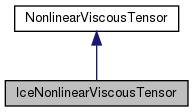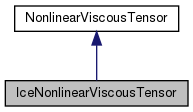Implement NonlinearViscousTensor for typical (velocity-depenendent) ice rheology. More...
#include <NonlinearViscousTensor.H>


Public Member Functions | |
| ~IceNonlinearViscousTensor () | |
| virtual NonlinearViscousTensor * | newNonlinearViscousTensor () |
| factory method More... | |
| IceNonlinearViscousTensor (const IceNonlinearViscousTensor &) | |
| IceNonlinearViscousTensor (const Vector< DisjointBoxLayout > &a_grids, const Vector< int > &a_refRatio, const Vector< ProblemDomain > &a_domains, const Vector< RealVect > &a_dxs, const Vector< RefCountedPtr< LevelSigmaCS > > &a_coordSys, const Vector< LevelData< FArrayBox > *> &a_u, const Vector< LevelData< FArrayBox > *> &a_C, const Vector< LevelData< FArrayBox > *> &a_C0, const int a_finestLevel, const ConstitutiveRelation &a_constRel, const BasalFrictionRelation &a_basalFrictionRel, IceThicknessIBC &a_bc, const Vector< LevelData< FArrayBox > *> &a_A, const Vector< LevelData< FluxBox > *> &a_faceFlowLawCoefficient, Real a_time, Real a_vtopSafety, int a_vtopRelaxMinIter, Real a_vtopRelaxTol, Real a_muMin=0.0, Real a_muMax=1.234567e+300, Real a_scale=1.0, Real a_artificialDragCoef=0.0, Real a_artificialDragPower=8.0) | |
| virtual void | setState (const Vector< LevelData< FArrayBox > *> &a_u) |
| set the state (velocity) More... | |
| virtual void | applyBC (Vector< LevelData< FArrayBox > *> &a_phi) |
| fill ghost cells of a_state as per the boundary conditions More... | |
| virtual Vector< LevelData< FArrayBox > * > & | getState () |
| retrieve the state More... | |
| virtual Vector< RefCountedPtr< LevelData< FluxBox > > > & | mu () |
| Retrieve the viscosity coefficient, mu. More... | |
| virtual Vector< RefCountedPtr< LevelData< FluxBox > > > & | lambda () |
| Retrieve the compressibility coefficient, lambda. More... | |
| virtual Vector< RefCountedPtr< LevelData< FArrayBox > > > & | alpha () |
| Retrieve the drag coefficient, alpha. More... | |
| virtual RefCountedPtr< AMRLevelOpFactory< LevelData< FArrayBox > > > | opFactoryPtr () |
| provide a pointer to an AMRLevelOpFactory<LevelData<FArrayBox> > defined at the current state More... | |
| virtual Vector< LevelData< FArrayBox > * > & | getC () |
| virtual void | setState (const Vector< LevelData< FArrayBox > *> &a_u, const Vector< LevelData< FArrayBox > *> &a_basalFrictionCoefficent) |
| virtual void | setFaceViscCoef (const Vector< LevelData< FluxBox > *> &a_muCoef) |
| virtual void | unsetFaceViscCoef () |
| virtual void | computeViscousTensorFace (const Vector< LevelData< FluxBox > *> &a_viscousTensor) |
 Public Member Functions inherited from NonlinearViscousTensor Public Member Functions inherited from NonlinearViscousTensor | |
| virtual | ~NonlinearViscousTensor () |
Detailed Description
Implement NonlinearViscousTensor for typical (velocity-depenendent) ice rheology.
Provides the means to compute the coefficients  ,
,  and
and  in
in ![$ L[u] = \nabla \cdot ( \mu(h,A(T),u) (\nabla u + (\nabla u)^T + \lambda \nabla. u I) - \alpha(u) u $](form_114.png) and provide the appropriate ViscousTensorOpFactory for a given
and provide the appropriate ViscousTensorOpFactory for a given  . Also provides the means to compute the stress tensor components
. Also provides the means to compute the stress tensor components
The velocity dependencies of  and
and  ,
,  are determined by BasalFrictionRelation and ConstitutiveRelation objects, while the velocity independent parts are set seperately, in the contructor and can be modified using setState, and setFaceViscCoef.
are determined by BasalFrictionRelation and ConstitutiveRelation objects, while the velocity independent parts are set seperately, in the contructor and can be modified using setState, and setFaceViscCoef.
The effective basal drag coefficient is computed as  , with fb defined by a BasalFrictionRelation, ie
, with fb defined by a BasalFrictionRelation, ie ![$ \tau _b = [ C f_b(u) + C_0 ] u $](form_119.png)
The effective viscosity is computed as  , with
, with  defined by a ConstitutiveRelation, and
defined by a ConstitutiveRelation, and 
Constructor & Destructor Documentation
◆ ~IceNonlinearViscousTensor()
| IceNonlinearViscousTensor::~IceNonlinearViscousTensor | ( | ) |
◆ IceNonlinearViscousTensor() [1/2]
| IceNonlinearViscousTensor::IceNonlinearViscousTensor | ( | const IceNonlinearViscousTensor & | a | ) |
Referenced by newNonlinearViscousTensor().
◆ IceNonlinearViscousTensor() [2/2]
| IceNonlinearViscousTensor::IceNonlinearViscousTensor | ( | const Vector< DisjointBoxLayout > & | a_grids, |
| const Vector< int > & | a_refRatio, | ||
| const Vector< ProblemDomain > & | a_domains, | ||
| const Vector< RealVect > & | a_dxs, | ||
| const Vector< RefCountedPtr< LevelSigmaCS > > & | a_coordSys, | ||
| const Vector< LevelData< FArrayBox > *> & | a_u, | ||
| const Vector< LevelData< FArrayBox > *> & | a_C, | ||
| const Vector< LevelData< FArrayBox > *> & | a_C0, | ||
| const int | a_finestLevel, | ||
| const ConstitutiveRelation & | a_constRel, | ||
| const BasalFrictionRelation & | a_basalFrictionRel, | ||
| IceThicknessIBC & | a_bc, | ||
| const Vector< LevelData< FArrayBox > *> & | a_A, | ||
| const Vector< LevelData< FluxBox > *> & | a_faceFlowLawCoefficient, | ||
| Real | a_time, | ||
| Real | a_vtopSafety, | ||
| int | a_vtopRelaxMinIter, | ||
| Real | a_vtopRelaxTol, | ||
| Real | a_muMin = 0.0, |
||
| Real | a_muMax = 1.234567e+300, |
||
| Real | a_scale = 1.0, |
||
| Real | a_artificialDragCoef = 0.0, |
||
| Real | a_artificialDragPower = 8.0 |
||
| ) |
The usual constructor.
- Parameters
-
a_grids hierarchy of AMR layouts a_refRatio refinement ratio from levels l to levels l + 1 a_domains domain boundaries for each level a_dxs mesh spacing for each level a_coordSys the ice sheet geometry a_u ice velocity a_C velocity independent part of the basal friction a_C0 additional basal friction, such that Tb = C * fb(u)*u + C0 * u a_finestLevel finest AMR level a_constRel velocity dependent part of the viscosity, fv(A, u) a_basalFrictionRel velocity dependent part of the basal friction, fb(u) a_bc Ice thickness and velocity boundary conditions a_A velocity independent part of the viscosity, A a_faceFlowLawCoefficient another velocity independent part of the viscosity, phi a_time a_vtopSafety [DEPRECATE?]
Member Function Documentation
◆ alpha()
|
inlinevirtual |
Retrieve the drag coefficient, alpha.
- Returns
- an amr hierarchy representing the coefficient
 , that appears in ViscousTensorOp as the coeffcient of the velocity
, that appears in ViscousTensorOp as the coeffcient of the velocity  .
.
Implements NonlinearViscousTensor.
Referenced by newNonlinearViscousTensor(), and AmrIce::updateViscousTensor().
◆ applyBC()
|
inlinevirtual |
fill ghost cells of a_state as per the boundary conditions
Implements NonlinearViscousTensor.
◆ computeViscousTensorFace()
|
virtual |
Provide the components of the Viscous Tensor G[ij] at cell faces, such that j-faces we have G[ij] for all i and so on
Referenced by InverseVerticallyIntegratedVelocitySolver::computeObjectiveAndGradient(), main(), and AmrIce::updateViscousTensor().
◆ getC()
|
inlinevirtual |
Retrieve the basal friction coeffcient (not the effective drag coeffient, alpha() )
◆ getState()
|
inlinevirtual |
retrieve the state
- Returns
- a reference to the current state (velocity)
Implements NonlinearViscousTensor.
◆ lambda()
|
inlinevirtual |
Retrieve the compressibility coefficient, lambda.
- Returns
- an amr hierarchy representing the coefficient
 , that appears in ViscousTensorOp as the coeffcient of the compression rate
, that appears in ViscousTensorOp as the coeffcient of the compression rate  .
.
Implements NonlinearViscousTensor.
Referenced by setState().
◆ mu()
|
inlinevirtual |
Retrieve the viscosity coefficient, mu.
- Returns
- an amr hierarchy representing the coefficient
 , that appears in ViscousTensorOp as the coeffcient of the strain rate
, that appears in ViscousTensorOp as the coeffcient of the strain rate  .
.
Implements NonlinearViscousTensor.
Referenced by AmrIce::updateViscousTensor().
◆ newNonlinearViscousTensor()
|
virtual |
factory method
Implements NonlinearViscousTensor.
References alpha(), IceNonlinearViscousTensor(), setFaceViscCoef(), and IceThicknessIBC::velocitySolveBC().
◆ opFactoryPtr()
|
inlinevirtual |
provide a pointer to an AMRLevelOpFactory<LevelData<FArrayBox> > defined at the current state
Implements NonlinearViscousTensor.
◆ setFaceViscCoef()
|
inlinevirtual |
Allows an additional coefficient f of the face-centered viscosity to be specified, so that H*mu*(grad(u) ... ) is replaced with f*H*mu*(grad(u) ... ).
Referenced by newNonlinearViscousTensor(), and JFNKSolver::solve().
◆ setState() [1/2]
|
virtual |
set the state (velocity)
Modify state, and thus the coefficients in the linear ViscousTensorOp: alpha, mu, lambda.
- Parameters
-
[in] a_state an amr hierarchy of velocity data
Implements NonlinearViscousTensor.
References BasalFrictionRelation::computeAlpha(), LevelSigmaCS::getFaceH(), lambda(), and IceThicknessIBC::velocityGhostBC().
Referenced by InverseVerticallyIntegratedVelocitySolver::computeObjectiveAndGradient(), main(), JFNKSolver::solve(), and AmrIce::updateViscousTensor().
◆ setState() [2/2]
|
inlinevirtual |
An overloaded setState, because beta changes with time
References NonlinearViscousTensor::setState().
◆ unsetFaceViscCoef()
|
inlinevirtual |
Reset to default (NULL) the coefficient set in setFaceViscCoef
The documentation for this class was generated from the following files:
 1.8.13
1.8.13